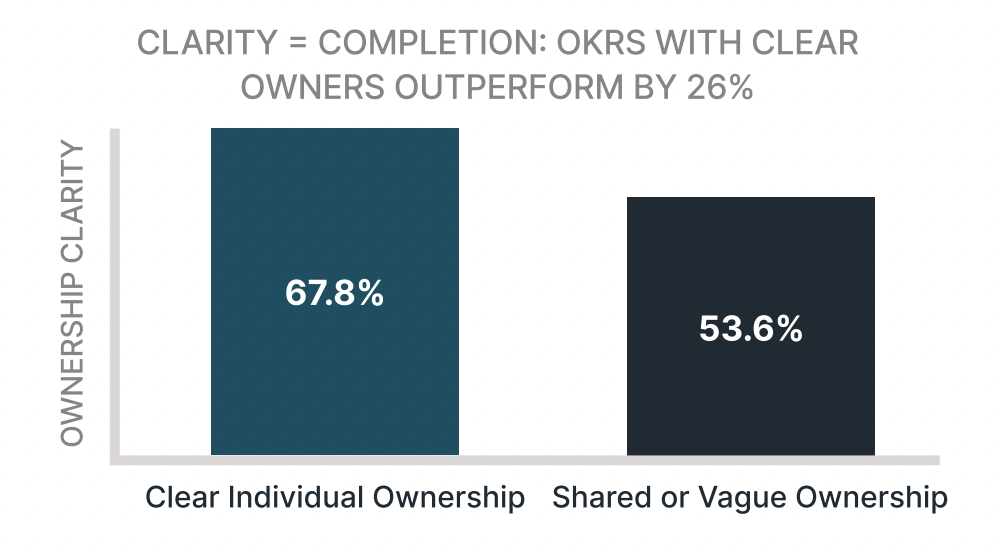Startups rarely fail because they lack ambition.
More often, progress stalls because teams can’t see - clearly, consistently, and objectively - whether they’re getting closer to the outcomes that matter.
In our latest research, 200 startups shared how they measure OKR success across cycles, teams, and company stages.
What we found was simple:
OKRs don’t win on ambition. They win on how well you measure progress.
Startups that define, track, and review success with intention see alignment improve faster, cycles run smoother, and team focus sharpen week over week.
This guide breaks down how to measure OKR success in a way that works for fast-moving teams - without adding weight or complexity.
What “OKR Success” Actually Means
Before measuring OKRs, it helps to clarify what “success” really looks like.
OKRs succeed when they:
- Drive meaningful, measurable change
- Create clear alignment across teams
- Help you make better decisions faster
- Reinforce ownership and focus
- Produce learning you can carry into the next cycle
It’s not only about whether you “hit the number.”
For startups, OKR success is about business impact, clarity, and momentum.
7 Ways to Measure OKR Success
To keep this actionable, each of the seven areas below includes a practical definition, what to look for, and how your team can measure it quarter over quarter.
1. Measure Success by Outcomes - Not Activity
The most reliable way to evaluate OKR performance is to look at the outcomes your team achieved, not the actions completed along the way.
For startups, this distinction is critical. Activity is infinite - launching campaigns, shipping features, releasing improvements - but none of those actions guarantee business results.
Outcomes reflect whether the work made a measurable difference, such as improved activation, increased revenue efficiency, or higher customer satisfaction.
To measure outcome success, define clear baselines and realistic targets at the start of the cycle. Then, evaluate progress based on movement in the metric, not the number of tasks completed.
Teams that do this well develop a clearer sense of which projects are truly high impact and which are simply consuming time. When done consistently, this creates a feedback loop that sharpens focus and drives better decision-making each quarter.
2. Assess Alignment Back to Company Goals
One of the most telling measures of OKR success is how well each objective ties back to the company’s top priorities.
Research from our benchmark report showed that 65% of teams admit their OKRs aren’t linked to company-level goals, even when they believe they are.
Yet alignment is the primary lever that turns individual team progress into company momentum.
To measure alignment, review each OKR against your quarterly or annual strategy. Ask whether achieving it directly contributes to a company priority such as revenue growth, retention, product quality, customer experience, or scalability.
You can also map OKRs visually to reveal gaps or areas of duplication. The teams who get this right avoid misdirection early, ensuring every cycle drives meaningful outcomes for the business - not just for individual teams.
3. Measure OKR Ownership and Accountability
Ownership is one of the clearest predictors of OKR effectiveness.
When a single person is responsible for each OKR, progress is easier to track and decisions happen faster. When ownership is diffused across many people, updates slow down and accountability blurs.
Benchmark data shows that teams with a single owner per OKR see a 26% lift in completion rates.

To measure ownership, review every OKR at the start of the cycle and confirm that one person - not a team, not a department - is accountable for reporting progress and driving outcomes.
Evaluate how consistently owners update their KRs, follow through on decisions, and communicate challenges early. Over time, you’ll see a direct connection between ownership clarity and cycle performance, especially as your team scales.
4. Track Check-In Consistency
Weekly check-ins remain one of the strongest indicators of OKR success.
They keep progress visible, highlight blockers early, and reinforce the rhythm that makes OKRs effective. Yet only a fraction of teams perform them consistently.
Our benchmark found that teams who check in weekly complete 43% more OKRs.

The problem isn’t effort - it’s consistency.
To measure check-in health, track how many weekly updates each team completes, how accurate the confidence scores are, and whether these check-ins influence weekly decision-making.
If updates become irregular or overly optimistic, OKR performance will almost always suffer. Treat consistency as a metric in itself; it’s a direct reflection of how well the system is working.
5. Evaluate Execution Velocity
How quickly teams turn a goal into tangible movement is one of the most important signs of OKR health. You can measure this by looking at how early measurable progress appears in the quarter - not just at the end.
Velocity shows whether teams are making momentum-building decisions early enough to influence the outcome.
- Low velocity often signals unclear ownership, hidden blockers, or overambitious scopes that need adjustment.
- High velocity indicates strong alignment, fast decision-making, and good visibility into work that matters.
One practical way to measure velocity is to review KR progress at the 25% and 50% points of the cycle. Healthy cycles show early movement, not a late rush. Tracking this trend over time gives your team a reliable indicator of overall OKR maturity.
6. Evaluate the Quality of the Key Results
High-quality Key Results are measurable, outcome-focused, and rooted in metrics that matter. Low-quality KRs are activity-based, vague, or disconnected from the broader objective.
Measuring KR quality is one of the most overlooked aspects of OKR success - but one of the most important. Strong KRs make progress easy to evaluate and create objective clarity around what success looks like. Weak KRs create confusion, misalignment, and cycle drift.
To measure KR quality, review KRs at the start of each cycle and check:
- Does this KR change a meaningful metric?
- Is it measurable and time-bound?
- Does it reflect impact, not activity?
Teams that rewrite KRs to focus on measurable outcomes build significantly stronger cycles, quarter after quarter.
7. Measure Learning and System Improvement
OKR success isn’t just about hitting goals - it’s about improving the system that produces results.
Teams that reflect at the end of each cycle consistently outperform those that don’t.
In our 2026 benchmark, teams that skipped retros completed 30–45% fewer OKRs. Reflection helps teams identify which approaches worked, which didn’t, and what changes will improve outcomes next quarter.
To measure learning, document insights from each cycle and review them before planning the next. Look for repeated blockers, misalignment patterns, or systemic issues that slow execution.
Over time, these insights compound and lead to smoother, more predictable OKR cycles - even as your organization grows.
A Simple Scoring Framework
A practical way to evaluate OKR success is to score each key result using a simple 0–1 scale:
- 1.0 - Target achieved or exceeded
- 0.7 - Strong progress, meaningful improvement
- 0.3 - Partial progress, outcome not reached
- 0.0 - No measurable improvement
This helps teams assess impact objectively - not emotionally - while preserving space for learning.
How to Measure OKR Success
Most teams assume they’re measuring OKRs correctly, but when you compare best practice to what actually happens inside real startups, the gaps become obvious. This table shows where those gaps appear - and how to close them fast.
The gaps aren’t complicated to fix - they’re habit problems, not strategy problems. Small changes in rhythm, ownership, and focus create measurable improvements within a single OKR cycle.
Measuring Success Builds It
Measuring OKR success isn’t about judging performance - it’s about creating clarity. For startups especially, clarity is the multiplier that accelerates progress, improves alignment, and keeps teams focused on what truly moves the business forward.
When you evaluate OKRs through outcomes, ownership, alignment, and learning, you build a system that compounds over time. Every cycle becomes clearer than the last. Decisions get sharper. Teams stay more aligned. And progress becomes easier to see and easier to sustain.
Success isn’t only in the goals you set.
It’s in how you measure them - and how you use that insight to move faster with confidence.





